What is the impact of a pass-oriented versus a run-oriented offense on wins (i.e., is one strategy more successful?) and attendance (i.e., is more enjoyable to watch?) in automatic-qualifying (AQ) and non- AQ programs? To explore these areas, we analyzed the offensive passing and rushing statistics for each school (68 total schools, 4,358 total games) in the BCS over the past five seasons (2006- 2010), to see what effect style of play (run vs. pass) had on winning percentage and attendance. We separated the analysis in two groups: AQ and non-AQ 1
Our analysis employed a four-step approach:
AQ Schools
1. Among offensive metrics, the top four correlations with wins in AQ programs were (with highest first): rushing touchdowns, passing yards per attempt, rushing yards, and rushing attempts [table 1]. By contrast, the top four correlations with attendance were (with highest first): rushing yards, rushing touchdowns, rushing yards per attempt, and passing yards per attempt [table 2]. Notably, rushing metrics made up three of the top four correlations for wins and attendance, meaning that rushing statistics are more closely related to both wins and attendance in AQ programs.
2.Using additional statistical techniques 2 for wins, the rushing metrics for attempts, yards, and touchdowns all outperform passing metrics. In the case of yards per attempt, though, passing did have the stronger relationship with wins. Applying the same statistical techniques for attendance, we see a similar pattern. The difference here, though, is that rushing metrics outperform passing metrics for attempts, yards, touchdowns, and yards per attempt. What this means is that the metrics for rushing are individually more closely related to attendance than the metrics for passing.
3. You may ask: how strong are these relationships? The largest relationships that were found during these analyses were with yards per attempt. In general, (averaging across all schools) an increase of one passing yard per attempt for the season is associated with an increase of 28,761 in total yearly attendance; however, an increase of one rushing yard per attempt for the season is associated with an increase of 40,624 in total yearly attendance.
4. Our last step was to create composite measures for passing and rushing and see their relationships with wins and attendance. We created these composite measures by standardizing (giving them meaningful values on a normal curve) all eight offensive variables and then averaging the four passing and four rushing metrics. Not surprisingly, the composite rushing metric was more strongly related to both wins and attendance.
Throughout the analyses, we find that a good rushing game is what drives both wins and attendance at AQ schools.
Table 1 — Correlations of Offensive Metrics and Wins
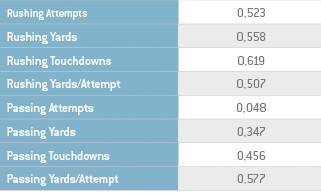
Table 2 — Correlations of Offensive Metrics and Attendance
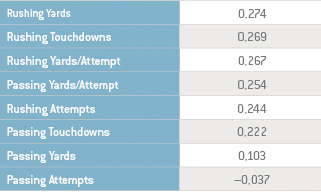
Non-AQ Schools
We used the same four-step approach for non-AQ schools. Part of what we found was a replication of results for AQ schools, but we did find one crucial difference. Rushing metrics are more closely related to both winning and attendance than passing metrics for AQ schools; however, for non-AQ schools, rushing metrics are more closely related only to wins, while passing metrics are more closely related to attendance.
1. We began by looking at the correlations with wins and attendance for our offensive metrics of interest. The top four correlations with wins were: rushing touchdowns, passing yards per attempt, rushing yards, and rushing yards per attempt [table 3]. The top four correlations with attendance were: passing yards per attempt, passing touchdowns, rushing touchdowns, and rushing attempts [table 4]. Rushing statistics were three of the top four correlations with wins; however, the major difference here is that passing statistics had the two strongest relationships with attendance. This is different from the strong relationships between rushing statistics, wins, and attendance among the AQ schools.
Table 3 — Correlations of Offensive Metrics and Wins
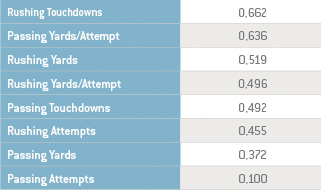
Table 4 — Correlations of Offensive Metrics and Attendance
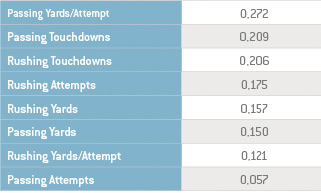
2. Next we further analyzed both passing and rushing statistics to see which more strongly predicted wins [fig. 1]. Just like with the AQ schools, rushing statistics outperformed passing statistics for attempts, yards, and touchdowns. Yards per attempt was the only case where a passing metric more strongly predicted wins over its rushing counterpart. Relationships with offensive metrics and attendance are where we start to see a major difference between AQ schools and non-AQ schools [fig. 2]. Passing statistics outperformed rushing statistics in predicting attendance for three of the four metrics that we analyzed. The only case in which a passing metric did not outperform a rushing metric in predicting attendance was what can be considered a statistical tie (touchdowns). What this means is that while rushing statistics are closely related to wins and attendance for AQ schools, this is not the case for non-AQ schools. Namely, for non-AQ schools, rushing statistics are closely related to wins, but attendance appears to be driven more by passing statistics.
3. What about the strength of these relationships? As with AQ schools, when we look at all non-AQ schools, the largest relationships were between yards per attempt and attendance. A one-yard increase in rushing yards per attempt for the season is associated with an increase of 1,856 in total yearly attendance. A one-yard increase in passing yards per attempt for the season is associated with an increase of 23,403 in total yearly attendance.
4. We again used composite passing and rushing metrics in predicting wins and attendance [fig. 3]. As you might have guessed, composite rushing better predicted wins than composite passing; however, composite passing better predicted attendance than composite rushing.
Fig. 1 — Offensive Metrics and Wins
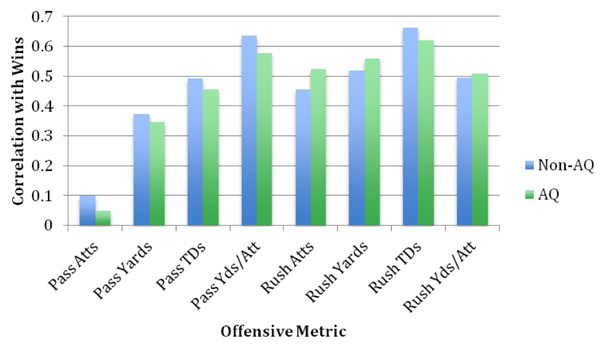
Fig. 2 — Offensive Metrics and Attendance
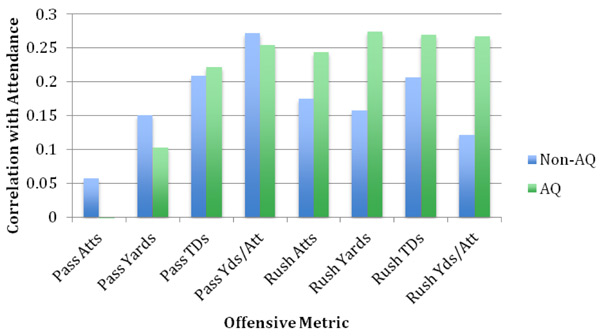
Fig. 3 — Offense: Wins and Attendance
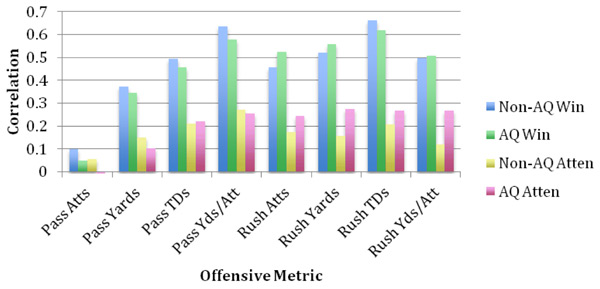
Conclusions
The variables that drive attendance in AQ and non-AQ schools are quite different. This could be because watching a passing game is more exciting. Even for non AQ schools who are not in the hunt for a national, divisional or conference championship, fans may not be as interested in winning games as they are in seeing an exciting game.
However, the same (rushing) metrics are associated with winning for both sets of schools. What this seems to suggest is that the route to winning is the same. The difference between sets of schools is how interested fans are in competing for a national championship (AQ) versus watching an exciting football game (non-AQ).
References:
- First, we measured the relationship between wins and attendance. What we found was that roughly 17% (for AQ schools) and 16% (for non-AQ schools) of attendance can be explained simply by how many wins a team might have in a given year. This means that these variables are clearly related. It also means that there is a lot of room for other variables to impact wins and attendance.
Next, we correlated passing and rushing metrics (by team) with both wins and attendance (year-end totals). We regressed two related passing and rushing metrics, (i.e., passing attempts and rushing attempts) onto wins and then onto attendance. We did this for attempts, yards, touchdowns, and also yards per attempt. In our final analysis we created composite measures of these metrics and regressed these onto wins and attendance.
As mentioned above, in the first step of our analyses we broke down different offensive metrics and correlated them with wins and attendance. The offensive metrics that we chose were: attempts, yards, touchdowns, and yards per attempt for both passing and rushing. ↩ - We entered corresponding passing and rushing metrics (i.e., rushing attempts and passing attempts) simultaneously into a regression equation to see which one more closely related to our outcome measures of wins and attendance. Entering both metrics simultaneously in our analyses allows us to look at the independent influence of each metric while controlling for the other. For example, when rushing attempts and passing attempts are both regressed onto wins, the coefficient for rushing attempts gives the relationship between rushing attempts and wins while controlling for passing attempts. ↩




